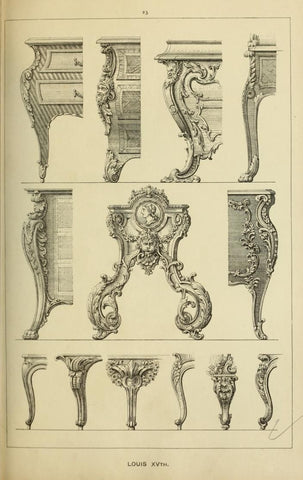
We've often heard about the Louis XIV, Louis XV, and Louis XVI styles of decoration, but it's often difficult to differentiate them. To do so correctly, it's necessary to analyze the shapes, materials, and colors. In this article, you'll find the key points to help you identify each style. Do you want to delve deeper into historical decoration?
The Louis XIV style 
The Louis XIV style emerged during the reign of Louis XIV of France, known as the "Sun King" (1638–1715). There was support for the arts, including literature, music, painting, and architecture. The construction of the Palace of Versailles, an architectural masterpiece, was particularly noteworthy.
In furniture, there were two types: "detailed," with gilded details, and "bourgeois," made of solid wood. Symmetry and imposing dimensions were common. Italian and antique influences were evident in the designs. Marquetry, especially that of Boulle, stood out with materials such as "écaille de tortue," brass, enamel, and ivory.
The style combined Baroque and Classicism, expressing monarchical power. It reached its peak under the direction of artists such as Charles Le Brun and Colbert. Boulle left a legacy in cabinetmaking with his marquetry technique.
The Louis XV style

During this period, furniture became more ostentatious than functional. The Baroque style was abandoned in favor of the much more ornate Rococo.
Curves predominate on the legs and arms of armchairs, dressers, and hall tables. Although there is asymmetry in the shapes, it is usually barely noticeable to the naked eye, as the designs cover the entire piece of furniture.
Styles include motifs such as shells, conches, rocks, birds, bouquets, and love scenes.
Gilded wood was a major feature of the period, often decorated with marquetry made of mother-of-pearl, shell, ivory, copper, or tin. Gilded bronzes, engravings, and chiselings were used to adorn the furniture, and a wide range of decorative elements were permitted.
The preferred woods are pear and ebony, combined with tapestries in green, blue, pink, beige, and matte gold tones. In short, the Rococo style is characterized by its lavish ornamentation and the incorporation of elegant and whimsical elements.
See catalogue of pieces in Louis XV style
The Louis XVI style 
After the period of excess and profuse ornamentation, the new period that developed between 1760 and 1790 is noted for its simplicity and moderation, returning to the rigor of geometric forms, with an emphasis on rectangles, squares, and ovals.
Furniture took on a more austere, sober, and elegant character during this period. This style emerged in part as a result of the excavations of the Roman cities of Pompeii and Herculaneum, and some of its shapes and motifs were inspired by Greek and Roman proportions, such as Doric columns and Greek masks. Symmetry and straight lines once again took center stage in design.
Decorative elements become more austere and symmetrical. Favorites of the era include ribbon bows and scalloped curtains with touches of gold in strategic places.
In contrast to earlier periods, the furniture is smaller and easier to transport. A characteristic element of this style is the incorporation of beading into the furniture, which adds a distinctive touch to the decor.
See catalog of pieces in Louis XVI style
With this information, you'll see that each style reflects the influences and tastes of its time, making them unique and recognizable in interior design.

